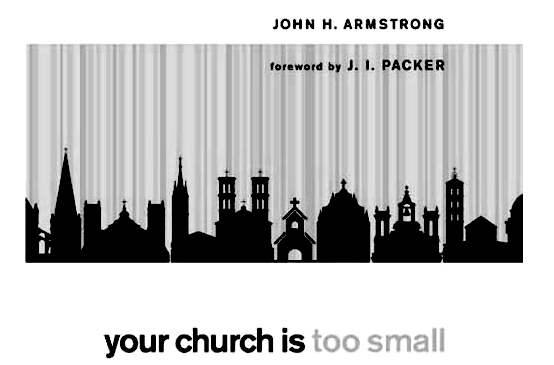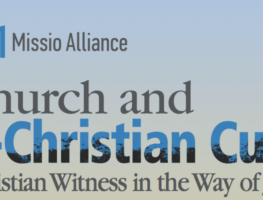In 1972 I planted a new suburban church. This was the time before church planting become “cool.”
In fact, planting a new church in the early 1970s was a bit odd. These were still the “dark ages” of recent evangelical history. Church Growth was starting to get its legs under it and run with increasing speed. The late Donald McGavran, along with his most famous pupil, C. Peter Wagner, had been professors of mine over several summers in the Wheaton Graduate School. In this context I felt a call to start a new, outreach-oriented, congregation. So I planted a new church, in a fast-growing suburban town fifteen miles away from my college, which was projected to grow exponentially over the ensuing decade. (The town did grow but not as much as the demographic planners had anticipated.) Mission as church planting was the in thing and mission in large suburban areas was becoming the new buzz for creative and evangelistic ministry. What was not in was “doing mission in unity.” This town was full of similar church-planting efforts. Some of us thrived and some of us failed, proving the Darwinian concept of Protestant individualism in a whole new way. Most of us church-planters young, innovative evangelical missionaries invading these fast-growing towns with the goal of establishing our kind (brand) of church. These were heady times to be a young star. I completed a graduate degree in missions and then began work on a doctorate. I received many accolades for my work and was celebrated as a church-planting role model in several circles. But I knew something was profoundly wrong.
After we got this congregation up and going I moved back to my college town (Wheaton, IL) to become the pastor of a different congregation for the next sixteen years. It was here that I ran into problems, some of which I created and some of which I inherited. A train wreck followed. Within two years I was a new kind of church-planter. I had a small group, a building, a big debt and a bushel full of unsought challenges. I felt strongly that I should not flee the scene of the crash so I remained for fourteen more years after a messy schism. During that time I was humbled and crushed by the weight of the ministry and by my own failures. In 1988 I hit a wall and descended into profound depression. My drive to succeed had ruined everything. I felt like a total failure. Every time I went to my church office I sensed something was wrong. But I plowed on being faithful to my work as I understood it. Then the depression became so intense that I was in trouble. No one knew except my wife. I just kept working and preaching and trying to care for the people. Graciously God met me and taught me to stop all this nonsense that I had bought about Church Growth and success in ministry. I relaxed, found hope in grace, and finally found deep peace in the pastoral ministry.
During those sixteen years I began a regular meeting for ministers and through this forum made many friends who were also pastors. These relationships changed my life. I saw so much of me in them, and a lot of them in me. Spending time with the “other” made me acutely aware of how small my vision of the church really was after two decades of pastoral work. The problem was quite clear – my church was too small. But it was not small because the congregation wasn’t large enough to be important but because the pastor and the people had no clue about what Jesus meant in John 17:21 when we prayed that his church would be one. Then a day came when my vision of the church was altered in a way that is still unfolding to this present day.
The day I have in my mind was my final Sunday as pastor of this deeply-loved congregation. In the afternoon of my final Sunday a special good-bye service and social event was planned. What made this day quite unique was that I was also being commissioned in the same service where they were saying goodbye so I could serve a growing circle of pastors and churches by going as far as the Spirit would send me to seek and pray for the gospel renewal to spread throughout the wider church. This call had grown out of my work with a unique trans-denominational community of leaders I had initiated when I was only thirty-two years old (1981). What I did not plan on that final Sunday (May, 1992) was just how the Spirit would change my direction so profoundly. Have you ever thought you knew exactly where God was leading you only to discover that there was a major curve in the road you never saw coming? That is how I felt after this emotionally drenched day came to an end.
In the two years prior to leaving this pastoral position I had been preaching through John’s Gospel. I realized as this ministry came to an end that I would not finish the entire Gospel since I was only in John chapter 17 when my final day arrived. The next text, if I followed my readings in sequential order, was John 17:21-26. I could not decide how to approach a final sermon so I concluded that I should simply preach from the great prayer of our Lord Jesus at the end of John 17, a prayer for our oneness as Christians.
Two years later, as I was worshiping in a rather large church where my wife and I had decided to attend after I left my parish work, we came to the time in the liturgy where the congregation affirmed the Apostles’ Creed. I had read and recited the creed. I had even begun to study it in some depth. But on this day, in 1994, something unusual happened. When I said the words, “I believe in one, holy, catholic church” I was struck by the Spirit’s energy and insight standing the spot. (I still recall exactly the spot where I was in that large sanctuary. I have written about this story and I’ve called this moment “my third conversion.”) This one line in the Creed has led me to ask a question in various contexts ever since. “Have you ever seen a 43 year-old man say the words of the Apostles Creed and begin to weep?” That is exactly what happened. I later realized what had transpired. I was weeping for two reasons. First, I saw something that I had never seen so clearly before. I saw the words of this text that we’ve read from Ephesians 4. There was only “one” church and Jesus prayed for it to be one in both spirit and practice. Whatever “one” meant in the Creed I needed to know. Then I saw that I must, with God’s help of course, put this prayer into practice as best I could. I must become a relational bridge for the truth of this oneness.
What was happening to me, now more than twenty years ago, was another step in a life-long journey that was being affirmed by the Holy Spirit.
—



Missio Alliance Comment Policy
The Missio Alliance Writing Collectives exist as a ministry of writing to resource theological practitioners for mission. From our Leading Voices to our regular Writing Team and those invited to publish with us as Community Voices, we are creating a space for thoughtful engagement of critical issues and questions facing the North American Church in God’s mission. This sort of thoughtful engagement is something that we seek to engender not only in our publishing, but in conversations that unfold as a result in the comment section of our articles.
Unfortunately, because of the relational distance introduced by online communication, “thoughtful engagement” and “comment sections” seldom go hand in hand. At the same time, censorship of comments by those who disagree with points made by authors, whose anger or limited perspective taints their words, or who simply feel the need to express their own opinion on a topic without any meaningful engagement with the article or comment in question can mask an important window into the true state of Christian discourse. As such, Missio Alliance sets forth the following suggestions for those who wish to engage in conversation around our writing:
1. Seek to understand the author’s intent.
If you disagree with something the an author said, consider framing your response as, “I hear you as saying _________. Am I understanding you correctly? If so, here’s why I disagree. _____________.
2. Seek to make your own voice heard.
We deeply desire and value the voice and perspective of our readers. However you may react to an article we publish or a fellow commenter, we encourage you to set forth that reaction is the most constructive way possible. Use your voice and perspective to move conversation forward rather than shut it down.
3. Share your story.
One of our favorite tenants is that “an enemy is someone whose story we haven’t heard.” Very often disagreements and rants are the result of people talking past rather than to one another. Everyone’s perspective is intimately bound up with their own stories – their contexts and experiences. We encourage you to couch your comments in whatever aspect of your own story might help others understand where you are coming from.
In view of those suggestions for shaping conversation on our site and in an effort to curate a hospitable space of open conversation, Missio Alliance may delete comments and/or ban users who show no regard for constructive engagement, especially those whose comments are easily construed as trolling, threatening, or abusive.